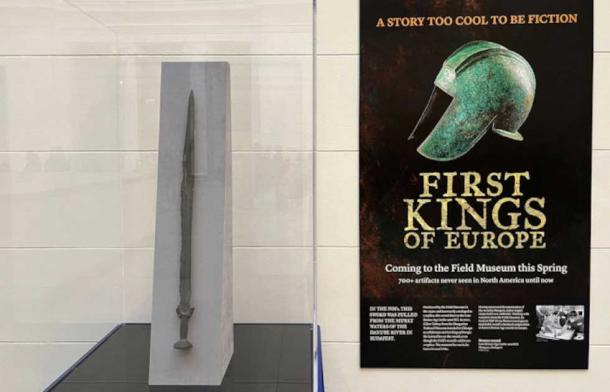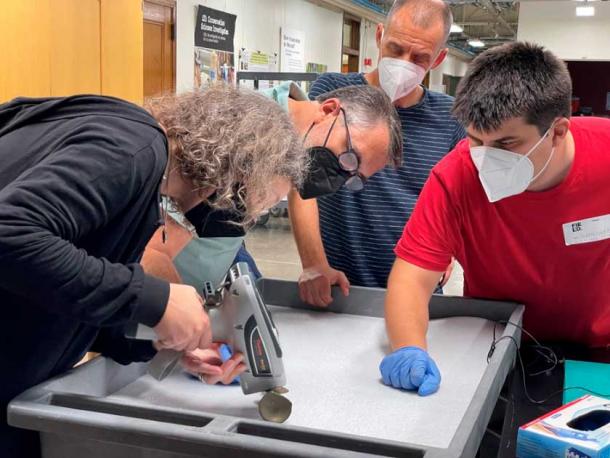
Chicago’s “Replica” Sword is Actually an Authentic 3,000-Year-Old Weapon
Over the last century a sword has been on display at the Field Museum in Chicago and dubbed a “replica Bronze Age weapon.” However, an x-ray has now disclosed that this brutal device of death is actually a bona fide 3,000-year-old artifact!
In the 1930s, a team of Hungarian archaeologists recovered the sword from the banks of the Danube River in Budapest, where it runs through Hungary’s capital city. Museologists in Chicago had always regarded the weapon as a “replica” Iron Age sword, but it turns out that this interpretation was way off the mark.
- Fine-Tuning Radiocarbon Dating Will Rewrite History!
- Dating Methods in Archaeology. Are They Accurate?

A supposed “replica” sword in Chicago has been authenticated by experts. (Field Museum)
The Field Museum of Natural History in Chicago, Illinois, acquired the sword from The Hungarian National Museum in the 1930s. At some point during the transportation of the weapon from Hungary to the United States it was incorrectly labelled as a replica. However, after recent tests it has been revealed that the so-called replica was actually forged in the Late Bronze Age, some 3,000 years ago.
Probing the Replica Sword with Modern Dating Technology
A report in CBS News explains that last year a Hungarian archaeologist spent time at the Field Museum in Chicago helping to design a forthcoming exhibition entitled “The First Kings of Europe” which opens at the end of March. The archaeologist began to suspect that the sword might be a Bronze Age original and he convinced museum authorities to have it dated.
A mobile X-ray unit was brought to the museum enabling the specialists to analyze the sword’s chemical composition. According to CBS News, William Parkinson at the Field Museum said his team knew that if the sword was indeed 3,000 years old it would have a certain chemical signature. When the results came in “that’s when they [museum authorities] got the ultimate surprise.”

Scientists using an XRF gun to test the sword’s chemical composition (© Field Museum)
The Ultimate Surprise: Replica Sword Was Actually Authentic
Waiting for the results, the museum staff knew that if the sword had indeed been crafted in bronze, then the chemical analysis would show a particular quotient of copper and tin in the alloy, with tiny amounts of unwittingly added trace metals. Speaking of the test results Parkinson at the Field Museum said the chemical structure was “Bam! Right where it should be” for a 3,000-year-old sword.
A 2019 paper by archaeologist Gábor Szabó of Eötvös Loránd University in Budapest researched Late Bronze Age communities populating the forest-covered hills and mountains of the Carpathian Basin. The author claimed that the prehistoric people created what are regarded as “perhaps the most colorful and numerous range of artifacts before the Roman conquest.” Researchers have unearthed ingenious tools for cultivating previously unbroken land, foundations from dozens of settlements and hoards of battle-worn weapons and other dark devices of war.
These People Left Behind “a Dazzling Array of Spectacular Artifacts”
Szabó wrote that the most spectacular Bronze Age relics discovered in Hungary represent “a dazzling array” of valuable bronze and gold weapons, jewelry and a variety of tools and implements. Many of these well-preserved artifacts encapsulate ancient stories telling of brave adventures in new lands, deeply-esoteric rituals and the toils of bloody-thirsty territorial wars.
- This Rare Battle-Sword Just Found in Sweden Is “An Evolutionary Leap”
- Chinese Votive Sword Found in Georgia suggests Pre-Columbian Chinese travel to North America
The newly identified Bronze Age sword at Chicago’s Field Museum falls into the latter category, and it is a rare heritage item from an antique battle. While this sword will be featured in “The First Kings of Europe” exhibition in March 2023, the rare ancient weapon is currently on display at the Field Museum in Chicago.
When it comes to how the sword got into the Hungarian river in the first place, the museum staff suspect it was either fought with in battle or was ritually deposited in water after a battle “in memory of lost loved ones,” explained the CBS News article.
Top image: Left: Scientists using an XRF gun to test the sword’s chemical composition. Right: Bronze Age Era sword (1080-900 BC) now proved not to be a replica. Source: © Field Museum
By Ashley Cowie















